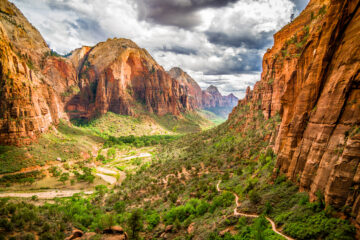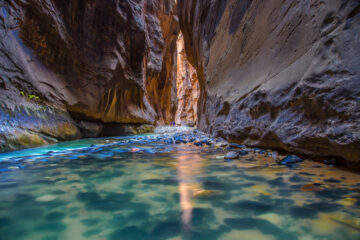Death Valley National Park
Death Valley National Park offers unique geology making stunning backdrops for camping and exploring. There are plenty of opportunities for adventure and discovery throughout the whole park. Located in eastern California, near Joshua Tree National Park and the Sierra Nevada mountain range, campers can easily plan a multi-day trip. There are a number of things you need to keep in mind when visiting this remote park where temperatures can reach a whopping 120 degrees in the summer. The YGG team has carefully curated this 3-day itinerary for Death Valley National Park so you don’t miss anything.
Day 1:
- Start your day at Zabriskie Point to witness the sunrise over the badlands.
- Head to Dante’s View for panoramic views of the valley below.
- Drive to Badwater Basin, the lowest point in North America, and hike the easy Badwater Salt Flat Trail.
- After lunch, visit the Artist’s Palette, an area with colorful rock formations, and hike the Artist’s Drive Trail.
- End your day with a visit to Mesquite Flat Sand Dunes, where you can hike or simply enjoy the scenery at sunset.
Day 2:
- Begin your day by driving to Titus Canyon, where you can hike the 2.6-mile trail or take a guided tour through the narrow canyon.
- After lunch, visit the Ubehebe Crater, a volcanic crater that’s half a mile wide and 500 feet deep.
- Drive to Scotty’s Castle, a historic mansion that offers tours of the estate and grounds.
- End your day with a visit to the Racetrack, where you can see the mysterious moving rocks.
Day 3:
- Start your day with a hike to Darwin Falls, a hidden waterfall oasis in the desert.
- Visit the Harmony Borax Works to learn about the borax mining history of the park.
- Drive to the Furnace Creek Visitor Center to learn more about the park’s history and geology.
- End your day with a visit to the Mesquite Springs Campground, where you can enjoy stargazing under the dark skies.
Best Time to Visit:
The best time to visit Death Valley National Park largely depends on what you want to do while you’re there. Here’s a breakdown of what you can expect during each season:
- Fall (September to November): Fall is one of the most popular times to visit Death Valley, as temperatures start to cool down and the summer crowds begin to dissipate. The park’s many hiking trails and scenic drives become more comfortable to explore during this season.
- Winter (December to February): Winter can be a great time to visit Death Valley, especially for those looking to avoid the summer heat. However, it can also be chilly at night, with temperatures dropping below freezing in some areas. Winter is a great time for stargazing and wildlife viewing, and some visitors may even see snow on the park’s higher peaks.
- Spring (March to May): Spring is another popular time to visit Death Valley, as wildflowers bloom and temperatures start to warm up. The park’s landscapes come alive with vibrant colors during this season, and hiking and camping become more comfortable.
- Summer (June to August): Summer is the park’s peak season, but it is also the hottest time of year, with temperatures often exceeding 100 degrees Fahrenheit. Outdoor activities can be limited during the summer due to the extreme heat, so it’s important to take the necessary precautions and plan your visit accordingly.
Overall, the best time to visit Death Valley depends on your interests and tolerance for extreme temperatures. Many visitors prefer to visit during the cooler months of fall, winter, or spring, while others may prefer the more challenging but less crowded conditions of summer. It’s important to bring plenty of water and sun protection, regardless of the time of year you visit.



0 Comments